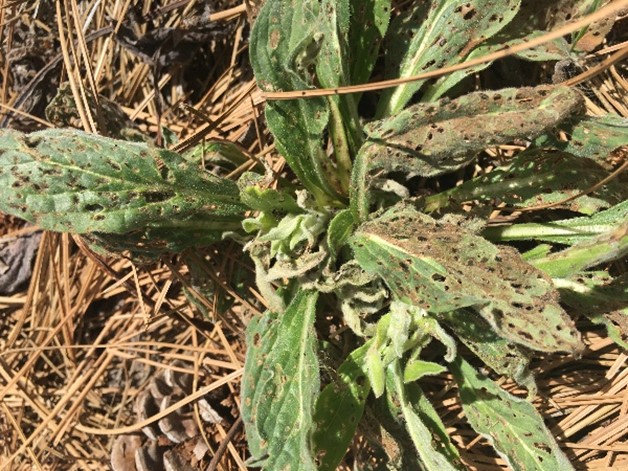Houndstongue Root Weevil (Mogulones crucifer)
By Melissa Maggio, Montana Biocontrol Coordination Project, [email protected]
Background

The houndstongue root weevil was approved for release in Canada in the late 1990s, where it has effectively suppressed houndstongue infestations. However, due to perceived risks to non-target plants, it is not currently an approved biocontrol agent in the U.S. Nevertheless, the weevil has made its way into Montana (see map). Regardless of its presence in Montana, it is illegal to aid in its movement.
Identification and Biology

Photo by Melissa Maggio. Adult weevil with white cross on back.
To identify the weevil’s presence in an area, look for adults on plants (spring and fall), larvae in roots (summer) and feeding damage on leaves (spring – fall). Adult weevils are 2-3 mm long and brown with a white cross on their backs. Larvae are 1-4 mm long, white with a brown head and curl in a C-shape in the roots. Feeding damage on leaves results in circular or oval holes.
Biology In spring adult weevils emerge from the soil where they overwinter. From spring to early summer, weevils feed on houndstongue leaves, mate and lay eggs at the base of the leaves. The larvae inflict the most significant damage by feeding on the roots. This feeding damage can result in plant death, prevention of flowering or a reduction in seed production. Larvae emerge from the roots to complete their life cycle in the soil. New adults emerge in late summer and early fall to feed on houndstongue foliage before overwintering in

Photo by Melissa Maggio. Weevil larva in root.
the soil.
Impacts
This weevil has been very effective at reducing houndstongue infestations in Canada and in the portions of the U.S. where it has naturally migrated. At sites where the weevil has been present for multiple years, houndstongue is rare or absent. Feeding on native plants in the same family as houndstongue has been documented in both Canada and the U.S., but to date this non-target attack seems minor, sporadic and temporary. The biggest concern is its potential impact to federally listed plant species.
Current Status
While the weevil is not currently approved as a biocontrol agent in the U.S., there is ongoing research to help inform the regulatory approval

Photo by Melissa Maggio. Houndstongue leaves with weevil feeding holes.
process. Research includes chemical ecology, continued lab and field cage tests, and a monitoring project occurring in Montana, Washington, and Idaho looking for impacts to plant species other than houndstongue in areas that the weevil has moved into naturally. Until approved, this weevil will continue to be considered an agricultural pest and, as such, cannot be intentionally moved.
Further Information
For more information about this month's weed post, contact Extension Invasive Plant Specialist Jane Mangold or Melissa Maggio with the Montana Biocontrol Coordination Project. Past posts are available in the Monthly Weed Post Directory.
This weed post is also available as a printable PDF (826KB).
